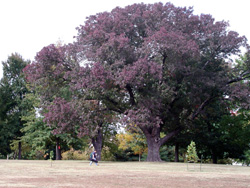Resource Library
Plant of the Week: White Ash
The University of Arkansas System Division of Agriculture does not promote, support or recommend plants featured in "Plant of the Week." Please consult your local Extension office for plants suitable for your region.
Plant of the Week
White Ash
Latin: Fraxinus americana

I had my first experience with white ash (Fraxinus americana) in the traditional, all-American way-my older brother taught me how to swing at a lobbed pitch. Though millions of people around the world have this same firsthand knowledge of white ash and can recognize the characteristic "thock" as bat meets ball, few would recognize the tree on sight.
White ash is a native deciduous tree belonging to the olive family. It is found in mixed forest sites from eastern Canada, through all the eastern states, and is only stopped by dry conditions in the short grass prairie region of the Great Plains. Trees are big, usually in the 70-to-80 foot range, but can reach as much as 120 feet. In its youth it tends to be round-headed with a strong central leader but with age it can spread wider than tall.
Like all ashes it has a compound leaf 10 to 12 inches long with seven leaflets. In the summer, the leaves have a deep green color on the upper surface and whitish, glaucous blooms on the undersurface. In the fall, this is the most handsome ash, with the leaves usually turning a handsome shade of burgundy.
Ashes are dioecious with individual trees either male or female. The flowers are of no ornamental value, but if pollinated by a nearby male, female trees can produce lots of seed that can become a nuisance in a garden setting. Most selected clones of white ash are males.
White ash lumber has characteristics that make it highly useful in many commercial applications. For its weight it is both strong and resilient, making it especially useful for uses where sudden stress is involved. Stresses such as the sudden impact of a 100 mph ball striking a two-pound bat swung with incredible force. Baseball bats are but the glamour use of the wood. It is also used for boat oars, canoe paddles, and all kinds of cabinetry.
Since Barry Bonds’ record-breaking 2001 season, ash bats have begun to lose some of their luster. Bonds used hard maple bats that have a denser wood than ash. Other big leaguers began switching to maple, but it soon became apparent these bats were more prone to breakage. Some players reported maple bats breaking every one to three games. But, when maple bats broke, the bat head and the ball both took off to parts unknown. Though there have been two investigations and discussion of banning the new maple bats, they still remain part of the game.
White ash is too big a tree for most urban gardens, but it could have a place in parks and large commercial properties. It does best in fertile, well-drained but reasonably moist soils. Trees are hardy from zones 4 through 9. A host of diseases and insects can potentially attack ash trees, so many experts are now shying away from using them in large mass plantings.
Nurserymen in the upper Midwest have selected a number of clones with good fall color development. Not all of these grow or color as well in southern or eastern locations, indicating there is room in the nursery market for locally selected forms with good fall color.
By: Gerald Klingaman, retired
Extension Horticulturist - Ornamentals
Extension News - February 5, 2010
The University of Arkansas System Division of Agriculture does not maintain lists of retail outlets where these plants can be purchased. Please check your local nursery or other retail outlets to ask about the availability of these plants for your growing area.